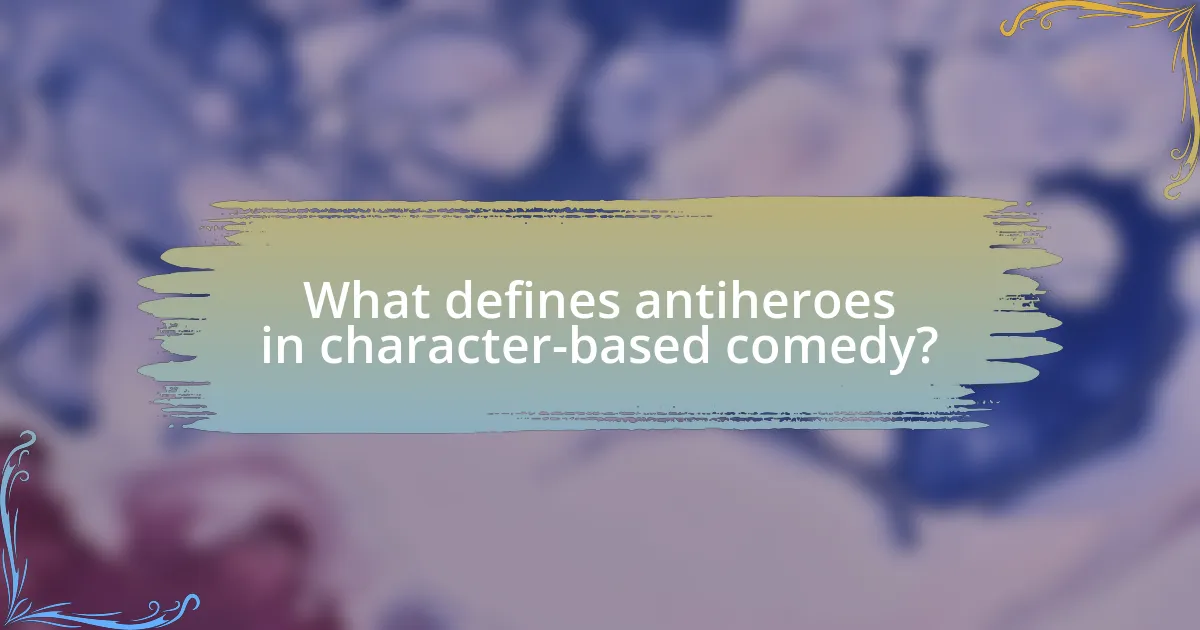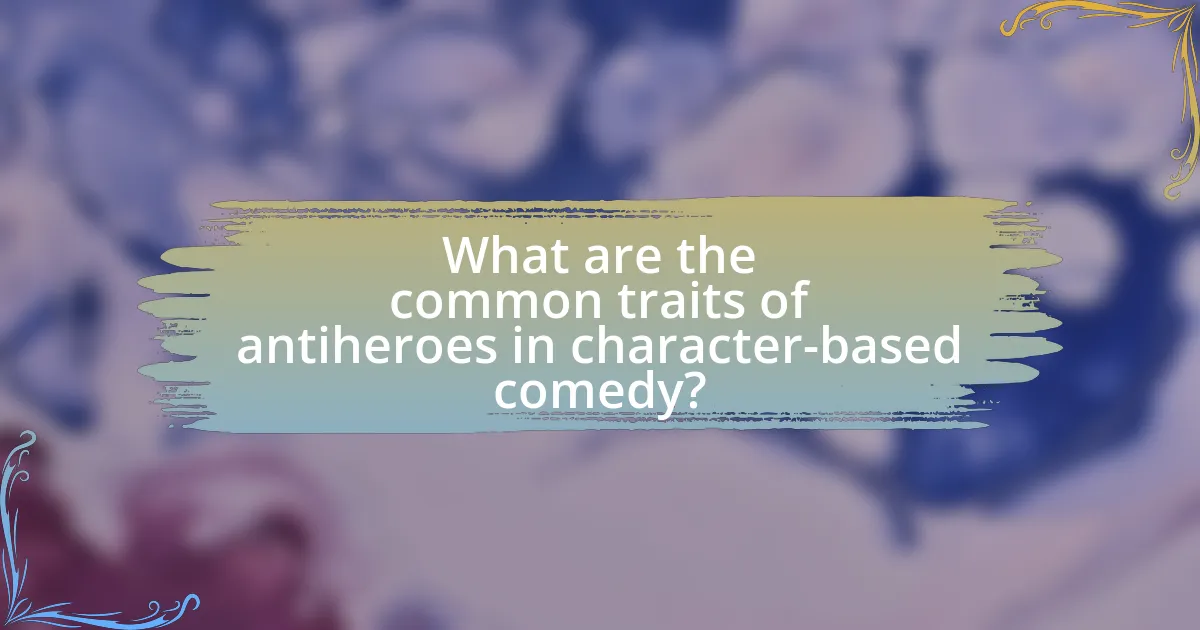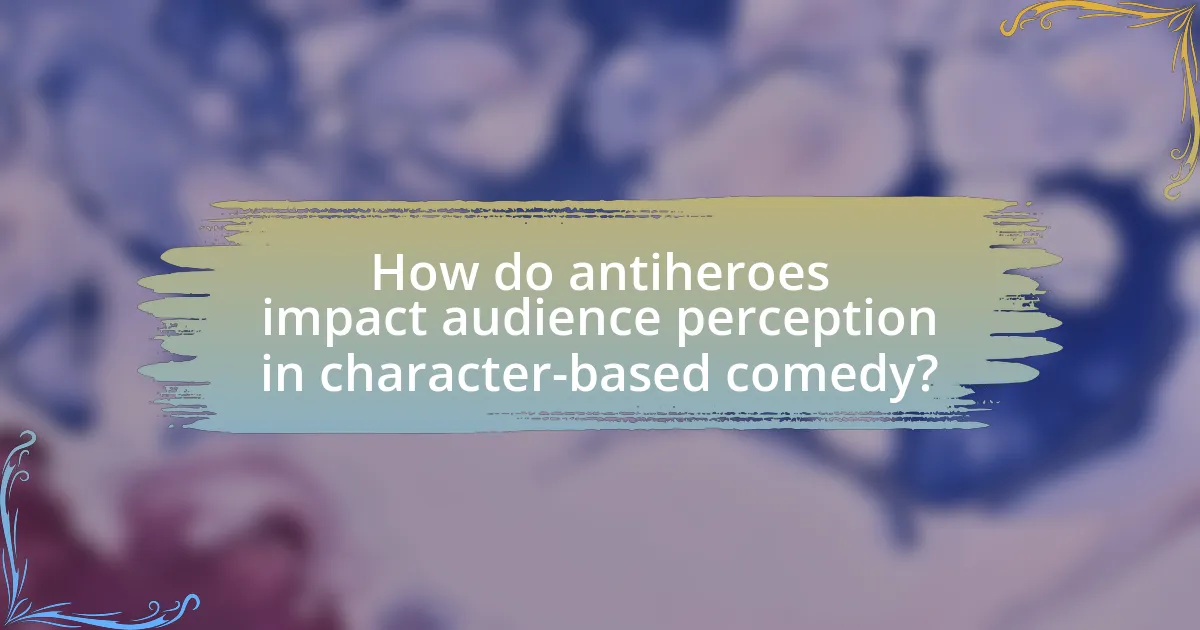Antiheroes in character-based comedy are defined by their morally ambiguous traits and flawed personalities, which often lead to humorous situations. This article explores how antiheroes differ from traditional heroes, highlighting their complexity and relatability, as well as their ability to challenge conventional moral standards. Key characteristics of antiheroes, such as self-interest and moral ambiguity, are examined, along with their impact on audience perception and emotional responses. The article also discusses the cultural shifts that have contributed to the rise of antiheroes in modern comedy, providing notable examples and best practices for creating relatable antihero characters.

What defines antiheroes in character-based comedy?
Antiheroes in character-based comedy are defined by their morally ambiguous traits and flawed personalities that often lead to humorous situations. These characters typically possess qualities that challenge traditional heroism, such as selfishness, cynicism, or a lack of social responsibility, which creates comedic tension and relatability. For instance, shows like “It’s Always Sunny in Philadelphia” feature characters who engage in unethical behavior, yet their antics elicit laughter, demonstrating how antiheroes can subvert expectations and provide a fresh perspective on morality in comedy.
How do antiheroes differ from traditional heroes in comedy?
Antiheroes in comedy differ from traditional heroes primarily in their moral ambiguity and flawed characteristics. While traditional heroes often embody virtues such as bravery, selflessness, and moral integrity, antiheroes typically display selfishness, cynicism, and a lack of conventional ethics, which creates humor through their unconventional behavior. For example, characters like Tony Stark in “Iron Man” or Frank Underwood in “House of Cards” often engage in morally questionable actions, yet their charm and wit make them relatable and entertaining. This contrast between their flaws and the expectations of heroism allows for comedic situations that challenge societal norms, making antiheroes a compelling choice in character-based comedy.
What characteristics make an antihero appealing to audiences?
Antiheroes appeal to audiences due to their complexity, moral ambiguity, and relatability. These characters often possess flaws and vulnerabilities that make them more human and accessible, allowing viewers to connect with their struggles. For instance, antiheroes like Walter White from “Breaking Bad” showcase a transformation driven by desperation, which resonates with audiences facing their own challenges. Additionally, their unconventional methods and willingness to break societal norms create tension and intrigue, keeping viewers engaged. This combination of depth and unpredictability enhances their appeal, as audiences are drawn to characters who defy traditional heroism while still embodying relatable human experiences.
How do antiheroes challenge conventional moral standards in comedy?
Antiheroes challenge conventional moral standards in comedy by embodying traits that subvert traditional notions of heroism and morality. These characters often engage in unethical behavior, such as deceit or selfishness, which creates humor through their unexpected actions and the resulting consequences. For example, in shows like “It’s Always Sunny in Philadelphia,” the characters frequently act in morally questionable ways, leading to comedic situations that highlight the absurdity of their choices. This approach allows audiences to explore complex moral dilemmas in a light-hearted context, prompting reflection on societal norms and personal ethics.
Why are antiheroes significant in modern character-based comedy?
Antiheroes are significant in modern character-based comedy because they challenge traditional notions of morality and heroism, allowing for more complex and relatable characters. This complexity resonates with audiences who appreciate flawed individuals navigating humorous situations, reflecting real-life imperfections. For instance, shows like “Breaking Bad” and “The Office” feature antiheroes whose morally ambiguous actions create comedic tension and depth, engaging viewers in a way that conventional heroes often do not. The popularity of these characters demonstrates a cultural shift towards embracing ambiguity and complexity in storytelling, making antiheroes a vital component of contemporary comedic narratives.
What cultural shifts have contributed to the rise of antiheroes in comedy?
The rise of antiheroes in comedy has been significantly influenced by cultural shifts towards individualism and the questioning of traditional moral values. As society has increasingly embraced complexity in character portrayal, audiences have shown a preference for flawed, relatable protagonists who reflect real-life struggles and imperfections. This shift is evident in the success of shows like “Breaking Bad” and “The Office,” where characters often engage in morally ambiguous behavior, challenging the conventional hero archetype. Additionally, the rise of social media has allowed for greater exploration of diverse narratives, enabling antiheroes to resonate with a broader audience seeking authenticity and humor in imperfection.
How do antiheroes reflect societal issues in their narratives?
Antiheroes reflect societal issues in their narratives by embodying the complexities and moral ambiguities of contemporary life. These characters often challenge traditional notions of heroism, showcasing flaws and ethical dilemmas that resonate with audiences facing similar real-world challenges. For instance, in the television series “Breaking Bad,” the protagonist Walter White’s descent into criminality highlights issues such as economic desperation and the failures of the healthcare system, illustrating how personal choices are influenced by societal pressures. This connection between antiheroes and societal issues allows for a deeper exploration of themes like justice, morality, and identity, making their stories relevant and thought-provoking.

What are the common traits of antiheroes in character-based comedy?
Common traits of antiheroes in character-based comedy include moral ambiguity, self-interest, and a tendency to subvert traditional heroic qualities. These characters often operate outside societal norms, displaying flaws such as selfishness or cynicism, which create humor through their unconventional behavior. For instance, characters like Tony Stark from “Iron Man” or Larry David from “Curb Your Enthusiasm” exemplify this by prioritizing personal desires over altruism, leading to comedic situations that challenge audience expectations of heroism. This blend of relatable imperfections and comedic timing makes antiheroes compelling and entertaining in the genre.
How do flaws and imperfections enhance the comedic value of antiheroes?
Flaws and imperfections enhance the comedic value of antiheroes by making them relatable and human, which allows audiences to connect with their struggles and failures. These characters often exhibit traits such as selfishness, arrogance, or moral ambiguity, which lead to humorous situations and misunderstandings. For example, in the television series “Breaking Bad,” Walter White’s descent into criminality is marked by his numerous flaws, creating darkly comedic moments that arise from his misguided decisions and the chaos that ensues. This blend of humor and moral complexity engages viewers, as they find amusement in the antihero’s misadventures while also reflecting on their own imperfections.
What role does self-deprecation play in the portrayal of antiheroes?
Self-deprecation serves as a critical tool in the portrayal of antiheroes by humanizing them and making their flaws relatable to the audience. This technique allows antiheroes to express vulnerability, which contrasts with their often morally ambiguous or outright negative behaviors. For instance, characters like Tony Stark in the Marvel Cinematic Universe frequently use self-deprecating humor to acknowledge their shortcomings, thereby fostering a connection with viewers who may see their own imperfections reflected in these characters. This relatability enhances audience engagement and complicates the moral landscape, as viewers may empathize with the antihero despite their questionable actions.
How do antiheroes’ relationships with other characters contribute to humor?
Antiheroes’ relationships with other characters contribute to humor through their unconventional interactions and moral ambiguity. These characters often engage in witty banter, sarcasm, and irony, which create comedic tension. For instance, the antihero’s disregard for social norms can lead to absurd situations, eliciting laughter from the audience. Additionally, their flawed nature often contrasts sharply with more traditional characters, highlighting the absurdity of their actions and decisions. This dynamic can be seen in shows like “Deadpool,” where the protagonist’s irreverent humor and interactions with more serious characters amplify comedic moments. Such relationships not only provide comic relief but also deepen character development, making the humor more relatable and impactful.
What types of antiheroes are prevalent in character-based comedy?
In character-based comedy, prevalent types of antiheroes include the lovable loser, the morally ambiguous character, and the self-absorbed narcissist. Lovable losers, such as characters in shows like “The Office,” often evoke sympathy despite their flaws, making them relatable and humorous. Morally ambiguous characters, like those in “It’s Always Sunny in Philadelphia,” challenge traditional notions of right and wrong, creating comedic tension through their questionable decisions. Self-absorbed narcissists, exemplified by characters in “Curb Your Enthusiasm,” provide humor through their obliviousness and self-centered behavior, often leading to socially awkward situations. These antiheroes resonate with audiences by subverting conventional heroism, thus enhancing comedic narratives.
How do different genres of comedy shape the portrayal of antiheroes?
Different genres of comedy significantly influence the portrayal of antiheroes by shaping their characteristics, motivations, and the audience’s perception of their actions. In dark comedy, antiheroes often engage in morally ambiguous behavior, allowing the audience to laugh at taboo subjects while reflecting on the complexities of human nature. For instance, shows like “Barry” depict a hitman struggling with his violent past, blending humor with ethical dilemmas, which invites viewers to empathize with his flawed character.
In contrast, romantic comedies typically present antiheroes as charming yet flawed individuals whose shortcomings are often romanticized, as seen in films like “10 Things I Hate About You,” where the antihero’s rebellious nature is framed as endearing. This genre encourages audiences to root for their redemption, emphasizing personal growth over moral integrity.
Furthermore, satirical comedies often use antiheroes to critique societal norms, as exemplified in “The Office,” where characters like Michael Scott embody incompetence and selfishness, yet their antics serve to highlight the absurdities of corporate culture. This genre allows for a more critical lens on antiheroes, prompting audiences to question their values and the systems they navigate.
Overall, the genre of comedy dictates how antiheroes are constructed and perceived, influencing whether they are seen as relatable, redeemable, or as vehicles for social commentary.
What are some notable examples of antiheroes in popular character-based comedies?
Notable examples of antiheroes in popular character-based comedies include Tony Stark from “Iron Man,” Michael Scott from “The Office,” and Frank Reynolds from “It’s Always Sunny in Philadelphia.” Tony Stark, portrayed by Robert Downey Jr., is a billionaire genius who often displays selfish and reckless behavior, yet his charm and intelligence make him a compelling character. Michael Scott, played by Steve Carell, is the bumbling regional manager whose misguided attempts at leadership often lead to cringe-worthy situations, showcasing his lack of self-awareness. Frank Reynolds, portrayed by Danny DeVito, embodies a morally ambiguous character whose outrageous antics and lack of ethics drive the humor in “It’s Always Sunny in Philadelphia.” These characters exemplify the antihero archetype by subverting traditional heroic traits while still engaging audiences through their flawed yet relatable personalities.

How do antiheroes impact audience perception in character-based comedy?
Antiheroes significantly influence audience perception in character-based comedy by challenging traditional moral frameworks and eliciting complex emotional responses. These characters often embody flaws and unconventional traits that resonate with viewers, allowing audiences to engage with their struggles and imperfections. For instance, shows like “It’s Always Sunny in Philadelphia” feature antiheroes whose morally ambiguous actions create humor while prompting viewers to reflect on their own values. This duality fosters a connection between the audience and the characters, as viewers may find themselves empathizing with the antihero’s plight despite their questionable behavior. Research indicates that audiences are drawn to antiheroes because they provide a sense of authenticity and relatability, which enhances comedic impact and deepens viewer engagement.
What emotional responses do antiheroes evoke in viewers?
Antiheroes evoke complex emotional responses in viewers, including empathy, admiration, and moral conflict. These characters often possess relatable flaws and vulnerabilities, which can lead audiences to empathize with their struggles and motivations. For instance, the antihero’s journey may mirror real-life challenges, prompting viewers to reflect on their own moral dilemmas. Additionally, the admiration stems from the antihero’s defiance of societal norms, which can resonate with viewers who appreciate rebellion against conventional expectations. However, this admiration is often accompanied by moral conflict, as viewers grapple with the antihero’s unethical choices, leading to a nuanced emotional experience that challenges traditional notions of heroism.
How do antiheroes create empathy despite their flaws?
Antiheroes create empathy despite their flaws by showcasing relatable struggles and vulnerabilities that resonate with audiences. These characters often face moral dilemmas, personal conflicts, or societal pressures that reflect real-life challenges, allowing viewers to connect with their experiences. For instance, antiheroes like Walter White from “Breaking Bad” or Tony Stark from “Iron Man” exhibit complex personalities where their flaws, such as pride or desperation, stem from deeper motivations like family or survival. This complexity invites audiences to understand their actions within a broader context, fostering a sense of empathy. Research indicates that characters with moral ambiguity can evoke stronger emotional responses, as viewers grapple with their imperfections while recognizing their humanity.
What role does humor play in shaping audience attitudes towards antiheroes?
Humor plays a significant role in shaping audience attitudes towards antiheroes by making them more relatable and likable despite their flaws. When antiheroes exhibit humor, it often disarms the audience, allowing them to empathize with characters who might otherwise be perceived as morally ambiguous or unlikable. For instance, characters like Tony Stark from the Marvel Cinematic Universe use wit and sarcasm to engage viewers, creating a connection that softens their more questionable actions. This comedic element can transform the audience’s perception, leading them to root for antiheroes rather than condemn them, as evidenced by the popularity of shows like “Breaking Bad,” where Walter White’s dark humor contributes to audience sympathy.
How can writers effectively develop antiheroes in character-based comedy?
Writers can effectively develop antiheroes in character-based comedy by creating complex, flawed characters who evoke both humor and empathy. This involves giving the antihero relatable motivations and vulnerabilities, allowing audiences to connect with their struggles despite their morally ambiguous actions. For instance, characters like Tony Stark from “Iron Man” or Walter White from “Breaking Bad” showcase how personal flaws can lead to comedic situations while still maintaining depth. By balancing humor with genuine character development, writers can craft antiheroes that resonate with viewers, making them both entertaining and thought-provoking.
What techniques can be used to balance humor and depth in antihero characters?
To balance humor and depth in antihero characters, writers can employ techniques such as juxtaposition, character flaws, and situational irony. Juxtaposition allows for contrasting moments of levity and seriousness, enabling the audience to see the complexity of the antihero’s personality. Character flaws, such as selfishness or moral ambiguity, can be played for laughs while simultaneously revealing deeper vulnerabilities, creating a multi-dimensional character. Situational irony can also enhance humor by placing the antihero in absurd or unexpected scenarios that highlight their flaws, making them relatable and engaging. These techniques have been effectively used in works like “Breaking Bad,” where Walter White’s dark choices are often contrasted with moments of dark humor, showcasing both his depth and the absurdity of his situation.
How can antiheroes be used to convey deeper messages in comedy?
Antiheroes can be used to convey deeper messages in comedy by highlighting the flaws and contradictions of human nature, allowing audiences to reflect on moral ambiguity. For instance, characters like Tony Stark in “Iron Man” or Walter White in “Breaking Bad” showcase complex personalities that challenge traditional notions of heroism. These characters often engage in morally questionable behavior, which serves as a vehicle for exploring themes such as redemption, the consequences of choices, and societal expectations. By presenting antiheroes in comedic contexts, creators can provoke thought and discussion about ethical dilemmas, ultimately leading to a richer understanding of human behavior and societal norms.
What are best practices for creating relatable antiheroes in character-based comedy?
To create relatable antiheroes in character-based comedy, writers should focus on developing complex personalities that blend flaws with redeeming qualities. This approach allows audiences to empathize with the character despite their morally ambiguous actions. For instance, incorporating relatable motivations, such as insecurity or a desire for acceptance, can enhance the audience’s connection. Additionally, using humor that stems from the antihero’s flaws, rather than solely their successes, can create a more engaging narrative. Research indicates that characters who exhibit vulnerability alongside their antiheroic traits tend to resonate more with viewers, as seen in shows like “Breaking Bad” and “Fleabag,” where the protagonists’ struggles evoke both laughter and sympathy.





